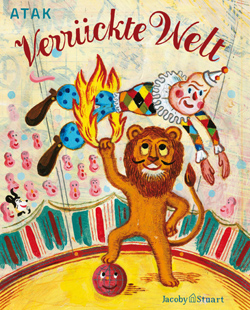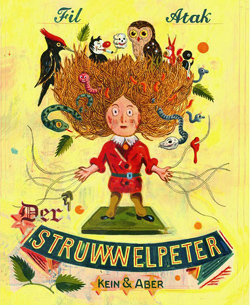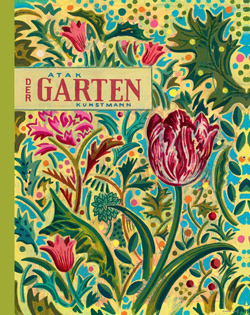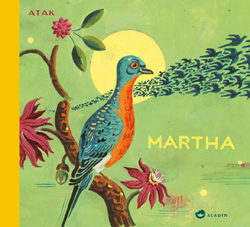< Back to posts
ATAK
Germany
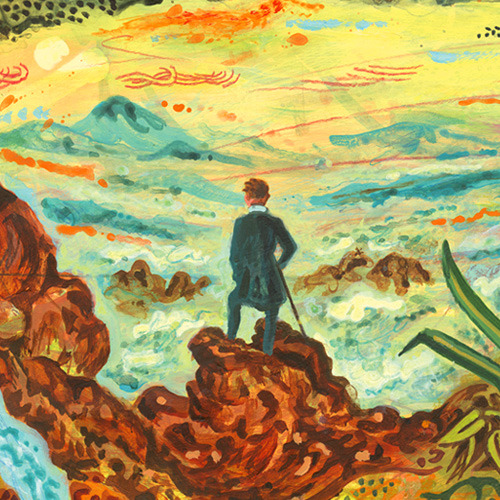
ATAK (Georg Barber) is an artist, graphic designer and illustrator living and working in Berlin. He’s had many solo exhibitions and worked on a variety of books, comics and illustrations for publications such as TIME and The New York Times. ATAK is also Professor of Illustration at the Burg Giebichenstein University of Art and Design in Halle.
In this post, ATAK talks about his fascinating creation process and he shares illustrations and development work from some of his wonderful books – including sketchbook pages for his forthcoming picturebook ‘Piraten im Garten’, which is due to be published in 2020.
ATAK: My process is like hip-hop. Mixing and sampling.
I have a big box where I put material that I’ve found on the street or in magazines. Then in the summer, when I’m sitting in the summer house, I stick everything into sketchbooks.
These are important books for me. I often use them when I’m looking for an idea. I like to make connections between this and that.
Sometimes I steal things. Here’s an example of where I used a painting by Caspar David Friedrich in one of my images. This is a very important painting for the German culture; it’s romantic. It’s the first painting that’s like a window. You see with him and you’re led into the picture.
‘Wanderer above the Sea of Fog’, Caspar David Friedrich, 1818.
When I take something to use in my own work, it’s more about the idea of composition and atmosphere. It’s not just a reference that people will know.
This is the sketchbook for my picturebook ‘Topsy Turvy World’. The publisher asked me for a book for children, and as I was tired of working with long texts, I thought this one should be a wordless book, where the images tell the whole story.
We have a German tradition from the 18th century of ‘bilderbogen’. This is like the origin of comics. They’re one-page stories. I was looking at some of these and I found some interesting ideas for ‘Topsy Turvy World’.
Here are some pages from the sketchbook.
Not everything made it into the final book; some of it was too heavy for my publisher, so he kicked it out. The smoking people had to go, otherwise we couldn’t have sold the rights in America.
Then there was a problem… My sketches had a lot of life and were fully-worked, so to transform them into the final artwork was very hard. After the rough version, I had this feeling that I was already finished with the book. Making the final ‘clean’ artwork felt like a kind of discipline.
My original paintings are always much bigger than they appear in the books. I never work to the correct size or format.
I often sell my paintings, but here is one I’ll never sell. It was done for the first children’s book I made, called ‘Comment la mort est revenue à la vie’ (How death came back to life), written by Muriel Bloch and published by Thierry Magnier.
It’s an important painting for me. I came from the comic world – black and white graphics – where I would draw out the whole scenes with all the details. In the middle of working on this painting, I had to go out to buy some food, and then I came back and thought, “Oh, it’s enough.” There’s a big difference when you work with colour. It’s like a sound, like a kind of music. This painting was very important for me in understanding colour.
Before I start working on an image, I often have a rough idea of what’s going to happen in the scene, but I leave a lot of space for other things to come in… And when I’ve started to work, I might see something in my studio or in a book, and it goes into the image.
I like this open process. And I like to be surprised. It’s very important for me that I don’t know in the beginning exactly what’s going to happen.
My way of painting is very old school. Traditional. Sometimes I paint over the top of something and you can see the trace of it behind. You can’t really fake things like this on the computer. For me, my original artwork is more important than the finished book. I once had an interesting discussion about this with Blexbolex. It’s completely the opposite for him: he sees his books as being the original artwork.
After ‘Topsy Turvy World’, I made a book called ‘The Garden’.
The original German edition was almost like a book for bourgeoise women… But for the French edition, they reimagined it for kids. It’s much bigger; you can really go inside. And the French publisher asked me to make some flaps to open up on the pages, which were not there in the original edition.
The sketches for ‘The Garden’ are almost nothing. It was very important that I didn’t repeat the process of ‘Topsy Turvy World’, where the sketches were very close to the finished artwork. I couldn’t work like this again. So the sketches here are very loose, but I knew exactly what was supposed to be in the pictures.
Working like this, you must have a very strong relationship with the publisher – one of absolute trust. I also have big problems with deadlines; I’m always late. With this book, my publisher Antje Kunstmann was so good. She phoned me every morning: “Hallo, here is Antje!” It was so important to know she was there, almost like a mother. It was a similar story with Wolf Erlbruch and his book ‘Duck, Death and the Tulip’. He was working for four years on this book. In the end, Antje came to his home and was waiting on his sofa for two days to take the last drawing!
The latest children’s book I made is called ‘Martha’.
I started working on it after reading an article in National Geographic about the passenger pigeon. I was fascinated. Because it’s a real story, it was not easy for me to make this book. It’s easier when I’m given a text because I have more distance.
Again, I worked very loosely in my sketchbook. These sketches are just indications – so I know something is here or somebody is there. It does help me that things are more open.
I don’t have sketchbooks where I draw from reality. I’m not good at this. You’ll never find me sitting in a crowd, making sketches. I watch and I observe instead. And I have books where I write ideas or note down interesting forms and shapes that I see.
Here are some pictures from ‘Martha’.
And here’s an idea for the dust jacket, where the kids could cut and draw on the paper, and make origami out of it to give a kind of rebirth. Martha is gone, but maybe she’s not gone if the kids could bring her back. The publisher didn’t go for this idea.
I went to art school but never finished. Just after the Berlin Wall came down, I was studying visual communication. There wasn’t a good atmosphere at my art school. I wanted to find like-minded people and work as a team, but it felt like most of the students were only interested in being artists, but not in working together. Then my daughter was born, and I never finished art school.
I’m now teaching art as a professor. The other teachers have diplomas, and I feel like I’ve come from the working class. I do like intellectual work, but when I work with students, I want to see something. I can only talk about what I see. I need it very visual. It has to catch me.
From when I was nine years old, I wanted to be an illustrator. In east Germany, illustration was a part of publishing. All the novels had illustration. It’s still unique now to see this, but in east Germany it was normal… So my plan was always to be an illustrator. This way I could wake up when I wanted, have no boss, listen to my music all day, and make my own work.
Speaking of music… The type of music I listen to when I work depends on the specifics of the book. For example, I made a book for Nobrow called ‘Ada’ (from a word portrait by Gertrude Stein). The idea for the artwork was to make handmade pixels, so I listened to a lot of electronic music; ping–ping–ping! It’s about energies. And for me, the music is also very important because I travel a lot and it can be hard to come back to your work – but when I listen to the music, immediately I’m back in the project, in the zone. It’s all connected – the music with the book.
Here’s my playlist for ‘Martha’.
Distortions – Clinic
Go – Sparklehorse & The Flaming Lips
VCR – The XX
Song For A Warrior – Swans
Avril 14th – Aphex Twin
Quiet Music – Nico Muhly
First Song For B – Devendra Banhart
Last Song For B – Devendra Banhart
How Can You Mend A Broken Heart? – Al Green
Ash Black Veil – Apparat
I Know They Say – Spectrum
Opus 55 – Dustin O’Halloran
Lost Fur – Karen O & The Kids
Unfinished Business – The Go-Betweens
Sometimes – My Bloody Valentine
Lies – Sin Fang Bous
Debussy: Suite Bergamasque, L 75 - Clair De Lune – Alexis Weissenberg
Nimrod (Adagio) – David Hirschfelder
Atmosphere – Joy Division
Still Life – Elliot Goldenthal
The Lake – Antony & The Jonhsons
Flying Birds – RZA
I used to make hardcore comics with friends. This was our first, which we made before the wall came down. My work has changed completely. I can’t understand this now; it’s like another man made it! And they are not funny. It’s a very small humour; you really have to look for it.
Then, after my daughter was born, I did my own comic series called ‘Wondertüte’. In the comic scene, everybody told me that this wasn’t a comic. But for me, it was totally a comic. I liked the comic medium, but I didn’t see why there had to be only one way. From all my old comics, this is the one I like the most.
The idea comes from the ‘learn English’ books we had in school. It’s a bit like a poem, but with a more open structure. I think my older work was very closed, and this comic is where it really started to open up. I made it for me, not for the mainstream. I got no money for it. But you could find it in kiosks. Somebody told me he saw it in a kiosk in a very small village. He said it was very important to see this comic displayed in-between all the nice, fancy stuff… My audience is not many people, but they are passionate.
I don’t really consider myself as a children’s book illustrator; it’s not like this. But it gives me a lot more freedom. Some of my friends find themselves working on one comic for years! I respect this, but for me that’s like a jail. With comics, you have to take such care with narration. You go from one panel to the next panel to the next… The comic medium is a question of time. In a children’s book, the reader looks at one page for perhaps two minutes or ten minutes. They go deep inside. It’s a completely different work. Also in a children’s book you have a stage; it’s really like theatre.
I also think it’s very important in children’s books that you read the book again and again. You read a comic maybe once and then you kick it out or you give it to somebody. But a children’s book is like a ritual between parents and kids.
This is a cover version of the German classic book ‘Der Struwwelpeter’.
The stories here are new and full of humour. I made this book with Fil (Philip Tägert). It was after ‘Topsy Turvy World’, and for me it was so important that I could be free with the pictures. The publisher said make what you want. And it felt so good.
There are hundreds of different versions of ‘Der Struwwelpeter’. As with the ‘bilderbogen’, this was like the beginning of comic stories.
I once found an old version of the book from Denmark with an extra chapter. They didn’t trust all that dark stuff and they made up new stories. So in our cover version, we had this idea to make one chapter where literally nothing happens! We tried to make it as boring as possible, with the pictures saying exactly the same thing as the words. It was so hard to make a boring illustration! It’s really not easy!
My new book will be published next year. It’s for my little son; he’s three years old. You could see it as a connection between ‘Topsy Turvy World’ and ‘The Garden’. It’s called ‘Pirates in the Garden’. The German title is ‘Piraten im Garten’, so the title is like a poem; you hear it and you don’t forget it. I like this title very much.
This book will will be very simple, a bit like Sesame Street. One word on each page, so you make associations between the word and the image, and the parents can talk about it with their kids.
I’m working in the sketchbook at the moment, and I want to make the sketches really good. For ‘The Garden’ and ‘Martha’, I kept the sketches really open. But for this one, no. I know this is going to be my last book for children. And it’s for my son, so I’m going to make it special. In the future, perhaps I’ll make art books in small editions, more paintings, stuff like this, but not books in a commercial way again.
When I made ‘Martha’, I was thinking, “who needs this?” It wasn’t mainstream and I was so confused. It’s different from when someone asks me to make a cover or a painting; I’m never thinking about who needs this. But this was different. Sometimes you just don’t know if what you’re doing is important or not. So I was kind of depressed working on that book. This is the main reason it took me such a long time.
I sometimes feel very alone working as a children’s book illustrator in Germany. My style is not at all mainstream and I always just made my books for fun. It was never a big passion of mine to make children’s books for my whole life. But I always liked the roots.
So for my final children’s book, ‘Piraten im Garten’, I will make it for myself and for my son.
Illustrations © ATAK. Post edited by dPICTUS.
Verrueckte Welt / Topsy Turvy World
ATAK
Jacoby & Stuart, Germany, 2009
A fantastical picturebook where mice chase cats, penguins live in the jungle, and cars fly! There’s few things that children enjoy more than catching grown-ups telling fibs. Discarding what’s obviously wrong is how they find out what’s right.
It’s a time-honoured children’s game; ATAK’s just given it a new twist, using lots of classic tall stories, and adding a few new ones as well.
- German: Jacoby & Stuart
- English: Flying Eye Books
- French: Editions Thierry Magnier
- Spanish: Fulgencio Pimentel
- Italian: Orecchio Acerbo
- Norwegian: Magikon
- Slovak & Czech: Baobab
- Portuguese: Planeta Tangerina (Portugal)
- Portuguese: Companhia das Letras (Brazil)
- Dutch: Boycott Books
- Chinese (Simplified): TB Publishing Ltd (Everafter Books)
Der Struwwelpeter
FIL & ATAK
Kein & Aber, Switzerland, 2009
Like a rock band covering their favourite songs, ATAK and FIL tackle the classic stories of Zappelphilipp, Hans-guck-in-die-Luft & Co.
And just as a Heavy Metal cover might sound harder than the original, you’ll also find tighter morals, harsher imagery, politically incorrect humour, and that ever-so-subtle touch of evil that has been pervading this book for more than 160 years.
Der Garten / The Garden
ATAK
Verlag Antje Kunstmann, Germany, 2013
In silence, the garden wakes up. Thus opens this picturebook by ATAK, as an invitation to walk in a garden with a thousand surprises – a haven of peace, populated with animals and strange characters.
You’ll discover with wonder, the treasures and the tranquility of the garden, and you’ll observe the seasons and the passing of time.
Martha
ATAK
Aladin Verlag, Germany, 2016
Martha tells the tale of the extinction of North America’s native Passenger Pigeon – its shockingly rapid decline caused directly by humans – and is told from the perspective of ‘Martha’, the last of the species who died at the Cincinnati Zoo in 1914. The story begins with a feeling of greatness and awe, describing flocks of birds that were once so numerous that they would darken the skies for days, their beating wings as loud as motors.
















































